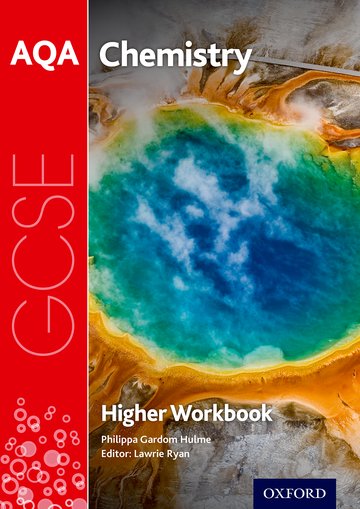AQA GCSE Chemistry Workbook: Higher
Consolidation and revision support in one AQA GCSE Chemistry workbook
Series Editor Lawrie Ryan and Author Philippa Gardom Hulme
Suitable for: 14-16 For all schools following the 2016 AQA GCSE Sciences (9-1) specifications
Price: £8.50
ISBN:
978-0-19-842168-9
Publication date:
07/09/2017
Paperback:
152 pages
Dimensions:
297x210mm
Availability: In stock.
You can use the basket to:
- pay by credit card
- order on account
- forward to a colleague
Description
Features
- This workbook is the perfect companion for the series and supports your Higher students on their journey from KS3 to success at GCSE
- Stretches and challenges students sitting higher tier in the 2016 AQA Chemistry GCSE
- Topics follow the order of the Student Book, with carefully designed questions to help capture important notes as students work through the course
- Plenty of engaging activities to help develop higher-order skills and deepen understanding of key concepts
- Questions and activities specifically focussed on the maths and practical skills required for the exam
- 'I can' checklists to help students monitor their own progress
- Hints to help students answer difficult questions
- UK schools save 40% on the RRP! The discount will be automatically applied when you order on your school account.
This page was last updated on 17 May 2024 at 20:30 GMT
Table of Contents
Chapter C1 Atomic structure
C1.1: Atoms
C1.2: Chemical equations
C1.3: Separating mixtures
C1.4: Fractional distillation and paper chromatography
C1.5: History of the atoms
C1.6: Structure of the atoms
C1.7: Ions, atoms, and isotopes
C1.8: Electronic structures
Chapter C2 The periodic table
C2.1: Development of the periodic table
C2.2: Electronic structures and the periodic table
C2.3: Group 1 - the alkali metals
C2.4: Group 7 - the halogens
C2.5: Explaining trends
C2.6: The transition elements
Chapter C3 Structure and bonding
C3.1: States of matter
C3.2: Atoms into ions
C3.3: Ionic bonding
C3.4: Giant ionic structures
C3.5: Covalent bonding
C3.6: Structure of simple molecules
C3.7: Giant covalent structures
C3.8: Fullerenes and graphenes
C3.9: Bonding in metals
C3.10: Giant metallic structures
C3.11: Nanoparticles
C3.12: Applications of nanoparticles
Chapter C4 Chemical calculations
C4.1: Relative masses and moles
C4.2: Equations and calculations
C4.3: From masses to balanced equations
C4.4: The yield of a chemical reactions
C4.5: Atom economy
C4.6: Expressing concentrations
C4.7: Titrations
C4.8: Titration calculations
C4.9: Volumes of gases
Chapter C5 Chemical changes
C5.1: The reactivity series
C5.2: Displacement reactions
C5.3: Extracting metals
C5.4: Salts from metals
C5.5: Salts from insoluble bases
C5.6: Making more salts
C5.7: Neutralisation and the pH scale
C5.8: Strong and weak acids
Chapter C6 Electrolysis
C6.1: Introduction to electrolysis
C6.2: Changes at the electrodes
C6.3: The extraction of aluminium
C6.4: Electrolysis of aqueous solutions
Chapter C7 Energy changes
C7.1: Exothermic and endothermic reactions
C7.2: Using energy transfers from reactions
C7.3: Reaction profiles
C7.4: Bond energy calculations
C7.5: Chemical cells and batteries
C7.6: Fuel cells
Chapter C8 Rates and equilibrium
C8.1: Rate of reaction
C8.2: Collision theory and surface area
C8.3: The effect of temperature
C8.4: The effect of concentration and pressure
C8.5: The effect of catalysts
C8.6: Reversible reactions
C8.7: Energy and reversible reactions
C8.8: Dynamic equilibrium
C8.9: Altering conditions
Chapter C9 Crude oil and fuels
C9.1: Hydrocarbons
C9.2: Fractional distillation of oil
C9.3: Burning hydrocarbon fuels
C9.4: Cracking hydrocarbons
Chapter C10 Chemical analysis
C10.1: Reactions of alkenes
C10.2: Structures of alcohols, carboxylic acids, and esters
C10.3: Reactions and uses of alcohols
C10.4: Carboxylic acids and esters
Chapter C11 Polymers
C11.1: Addition polymerisation
C11.2: Condensation polymerisation
C11.3: Natural polymers
C11.4: DNA
Chapter C12 Chemical analysis
C12.1: Pure substances and mixtures
C12.2: Analysing chromatograms
C12.3: Testing for gases
C12.4: Tests for positive ions
C12.5: Tests for negative ions
C12.6: Instrumental analysis
Chapter C13 The Earth's atmosphere
C13.1: History of our atmosphere
C13.2: Our evolving atmosphere
C13.3: Greenhouse gases
C13.4: Global climate change
C13.5: Atomspheric pollutants
Chapter C14 The Earth's resources
C14.1: Finite and renewable resources
C14.2: Water saafe to drink
C14.3: Treating waste water
C14.4: Extracting metals from ores
C14.5: Life Cycle Assessments
C14.6: Reduce, reuse, and recycle
Chapter C15 Using our resources
C15.1: Rusting
C15.2: Useful alloys
C15.3: The properties of polymers
C15.4: Glass, ceramics, and composites
C15.5: Making ammonia - the Haber process
C15.6: The economics of the Haber process
C15.7: Making fertilisers in the lab
C15.8: Making fertilisers in industry
© 2024 Oxford University Press. All rights reserved.









